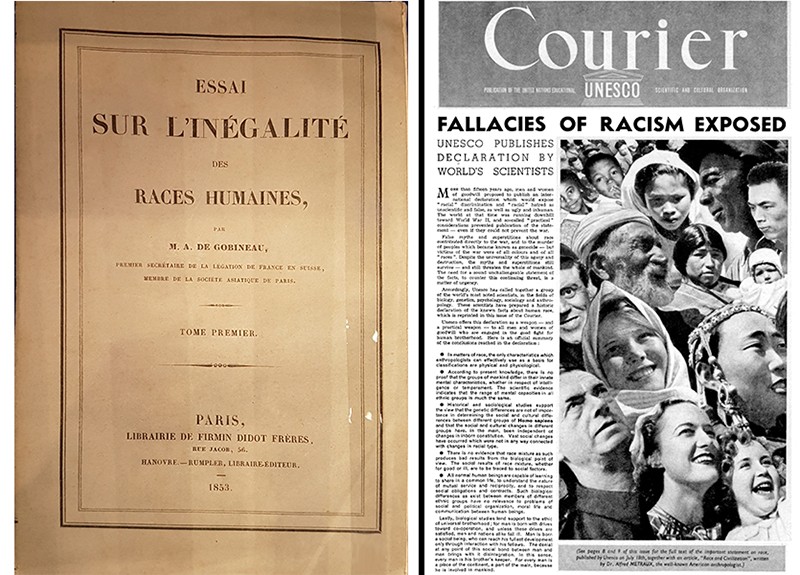Science is a human endeavour that is fuelled by curiosity and a drive to better understand and shape our natural and material world. Science is also a shared experience, subject both to the best of what creativity and imagination have to offer and to humankind’s worst excesses. For centuries, European governments supported the enslavement of African populations and the subjugation of Indigenous people around the world. During that period, a scientific enterprise emerged that reinforced racist beliefs and cultures. Apartheid, colonization, forced labour, imperialism and slavery have left an indelible mark on science.
Although valiant and painful freedom struggles eventually led to decolonization, the impacts of those original racist beliefs continue to reverberate and have been reified in the institutional policies and attitudes that govern the ‘who’ and ‘how’ of individuals’ participation in the modern, global scientific enterprise. In our opinion, racist beliefs have contributed to a lack of diversity, equity and inclusion, and the marginalization of Indigenous and African diasporic communities in science on a national and global scale.
Science and racism share a history because scientists, science’s institutions and influential supporters of science either directly or indirectly supported core racist beliefs: the idea that race is a determinant of human traits and capacities (such as the ability to build civilizations); and the idea that racial differences make white people superior. Although the most egregious forms of racism are unlawful, racism persists in science and affects diverse communities worldwide. Following the murder of George Floyd in 2020 and the expansion of the Black Lives Matter movement into science, Nature was among those institutions that pledged to listen, learn and change. In an Editorial1, it said, “The enterprise of science has been — and remains — complicit in systemic racism, and it must strive harder to correct those injustices and amplify marginalized voices.”
Related

Systemic racism: science must listen, learn and change
Nature invited us to serve as guest editors — notably, to advise on the production of a series of special issues on racism in science, the first of which is due to be published later this year. We accepted the invitation, although recognized the enormity of the challenge. How to define terms such as race, racism and scientific culture? How to construct a coherent framework of analysis: one that enables us to examine how racist beliefs in European colonial and post-colonial societies affect today’s scientists in countries that were once colonized; and how racism affects scientists of African, Asian, Central and South American and Indigenous heritage who are citizens and residents of former colonial powers?
We are committed to pursuing honest dialogue and giving a voice to those most affected by racism in science. But we also seek to provide readers with hope and optimism. Accordingly, our aim is to showcase some of the many examples of successful scientists who are Black, Indigenous and People of Colour, to highlight best practices and ‘lift-up’ programmes, and to feature initiatives that empower full participation and scientific leadership of African, Indigenous and diasporic communities around the world.
Articles will explore some key events and discoveries, drawn from both the scholarly literature and from lived experiences. Content will seek to understand the systemic nature of racism in science — including the institutions of academia, government, the private sector and the culture of science — that can lead either to an illusion of colour blindness (beneath which unconscious bias occurs) or to deliberate practices that are defiantly in opposition to inclusion. The articles will use the tools of journalism in all relevant media formats, as well as expert comment and analysis, primary research publishing and engagement, and will have a strong visual component.

Protestors attend a march for Black Lives Matter in Austin, Texas, in June 2020.Credit: Mario Cantu/CSM/Sipa US/Alamy
This opening Editorial — the first Nature has published signed by external authors — is a contribution to what will be a long, sometimes difficult, but essential and ultimately rewarding process for the journal and its readers, and, we hope, for its publisher, too. The journey to recognizing and removing racism will take time, because meaningful change does not happen quickly. It will be difficult, because it will require powerful institutions to accept that they need to be accountable to those with less power. It will be rewarding because it will enrich science. It is essential because it is about truth, justice and reconciliation — tenets on which all societies must be founded. As scientists, we know that where there are problems in the historical record, scientific rigour and scientific integrity demand that they be acknowledged, and, if necessary, corrected.
Look at the record
So how do we know that science has advanced racist ideas? We know because it is detailed in the published scholarly record. Some 350 years ago, François Bernier, a French physician employed in the court of the Mughal Emperor Aurangzeb, attempted to create a hierarchy of people by their skin colour, religion and geography2.
Such ideas came into their own when colonization was at its peak in the 1800s and early 1900s. In 1883, Francis Galton, an English statistician, coined the term eugenics for the study of human improvement through genetics and selective breeding. Galton also constructed a racial hierarchy, in which white people were considered superior. He wrote that “the average intellectual standard of the negro race is some two grades below our own (the Anglo Saxon)”3.
Although Charles Darwin opposed slavery and proposed that humans have a common ancestor, he also advocated a hierarchy of races, with white people higher than others. In The Descent of Man, Darwin describes what he calls the gradations between “the highest men of the highest races and the lowest savages”4. He uses the word ‘savages’ to describe Black and Indigenous people.
In our own times, James Watson, a Nobel laureate and co-discoverer of the DNA double helix, voiced the opinion that Black people are less intelligent than white people. In 1994, the psychologist Richard Herrnstein and the political scientist Charles Murray claimed that genetics was the main determinant of intelligence and social mobility in American society, and that those genetics caused African Americans and European Americans to have different IQ scores5.

Cover of an essay by the nineteenth-century French diplomat and social theorist Arthur de Gobineau justifying white supremacy (left). Scientists publish a statement through the UN affirming that race is a social construct and not a biological phenomenon (right).Credit: Left, Daehan (CC BY-SA 4.0); right, UNESCO Courier 1950
By 1950, the consensus among scientific leaders was that race is a social construct and not a biological phenomenon. Scientists affirmed this in a statement published that year by the United Nations science and education agency UNESCO (see go.nature.com/3mqrfcy). This has since been reaffirmed by subsequent findings showing there is no genetic basis for race, because humans share 99.9% similarity and have a single origin, in Africa6,7. There is more genetic variation within ‘races’ than between them.
Related

Caltech confronted its racist past. Here’s what happened
Researching race and science matters, not only because these ideas influenced science, but because they became attractive to decision-makers, with horrific effects. People in power who advocated or participated in colonization and/or slavery used science, scientists and scientific institutions to rationalize and justify these practices.
Take Thomas Jefferson, the third US president, who drafted the Declaration of Independence of 1776. Jefferson is widely considered to be among the founders of liberalism and the idea of meritocracy. The declaration includes some of the most well-rehearsed words in the English language: that “all men are created equal”. And yet Jefferson, who was both a scientist and a slave owner, also thought that people of African descent were inferior to white people.
In the mid-nineteenth century, the French diplomat and social theorist Arthur de Gobineau wrote an essay justifying white supremacy8. De Gobineau thought that “all civilizations derive from the white race none can exist without its help”. He argued that civilizations eventually collapse when different peoples mix. To advance his theory, he classified people according to their skin colour and social backgrounds. White aristocrats were given the highest category, Black people the lowest. De Gobineau’s ideas subsequently influenced the development of Nazi ideology, as did Galton’s — eugenics gained support among many world leaders, and contributed to slavery, apartheid and colonization, and the related genocide.

Addie Lee Anderson was involuntarily sterilized in 1950 by the Eugenics Board of North Carolina. She is pictured here in 2006 at the age of 87.Credit: Sara D. Davis/TNS/ZUMA Press
In the early decades of the twentieth century, many US states passed eugenic sterilization laws. For example, North Carolina enacted such a law in 1929; by 1973, approximately 7,600 individuals had undergone involuntary sterilization in the state. The laws initially targeted white men who had been incarcerated for mental-health disorders, mental disabilities or crimes, but were later used to target Black women who received welfare benefits. It is estimated that between 1950 and 1966, Black women in North Carolina were sterilized at 3 times the rate of white women, and at 12 times the rate of white men9.
Deconstruct, debate and decolonize
Even today, colonization is sometimes defended on the grounds that it brought science to once-colonized countries. Such arguments have two highly problematic foundations: that Europe’s knowledge was (or is) superior to that of all others, and that non-European cultures contributed little or nothing to the scientific and scholarly record.
These views are evident in the case of Thomas Babington Macaulay, a historian and colonial administrator in India during the British Empire, who famously wrote in 1835 that “a single shelf of a good European library was worth the whole native literature of India and Arabia”10. These were not idle words. Macaulay used these and similar arguments to justify stopping funding for teaching India’s national languages, such as Sanskrit, Arabic and Persian — which, he said, taught “false history”, “false astronomy” and “false medicine” — in favour of teaching English language and science. Some might question what is wrong with more English and science teaching, but the context matters. Macaulay’s intention (in his own words) was not so much to advance scholarship, but to educate a class of person who would help Britain to continue its Imperial rule.

Thomas Babington Macaulay, an influential British politician in colonial times, thought that to teach in Arabic and Sanscrit would be to teach “false history”, “false astronomy” and “false medicine”.Credit: Hulton Archive/Getty
The erasure of Indigenous scholarship in this way has had incalculably damaging effects on formerly colonized countries. It has meant that future generations in Africa, Asia and the Americas would be unfamiliar with an unbroken history of their nations’ contributions to knowledge, even after decolonization. At present, much of the work to uncover non-Western scholarship is taking place in the universities and research centres of high-income countries. That is far from satisfactory, because it exacerbates the power imbalance in research, particularly in collaborative research projects between high-income and low- and middle-income countries. Although there is much talk of ‘local ownership’, the reality is that researchers in high-income countries hold much more sway in setting and implementing research agendas, leading to documented cases of abuses of power.
The effects of historical racism and power imbalances have also found their way into the research funding and publishing systems of high-income countries11. The National Institutes of Health, the United States’ main funder of biomedical science, recognizes that there is structural racism in biomedical research. The funder is implementing solutions that are starting to narrow gaps. But not all funding institutions in high-income countries are studying or acknowledging structural or systemic racism in their funding systems or scholarly communities.
Restore, rebuild and reconcile
A wave of anti-racism statements followed Floyd’s murder in 2020. Research funders and universities, publishers and individual journals such as Nature all published statements in support of eliminating racism from science. Two years on, the journey from words to action has been slow and, in some respects, barely measurable.
Nature’s upcoming special issues, its invitation to work with us as guest editors and its ongoing coverage of racism in science are necessary steps to inform, encourage debate and, ultimately, seek solutions-based approaches that propose ways to restore truth, repair trust and seek justice.
We must have hope that the future will be better than the past, because every alternative is worse. But solutions must also acknowledge the reasons why solutions are necessary. Racism has led to injustices against millions of people, through slavery and colonization, through apartheid and through continuing prejudice today. The point of learning about and analysing racism in science must be to ensure that it is never repeated.
Nature 606, 225-227 (2022)
doi: https://doi.org/10.1038/d41586-022-01527-z
Editor’s note: Melissa Nobles, Chad Womack, Ambroise Wonkam and Elizabeth Wathuti are currently working with Nature as guest editors to guide the creation of several special issues of the journal dedicated to racism in science. To the best of our knowledge, this Editorial is the first in Nature to be signed by guest editors. We are proud of this, and look forward to working with them on these special issues and beyond.
Disclaimer: The opinions in this article do not necessarily reflect the views or policies of the authors’ organizations or their governing bodies.
References
-
Nature 582, 147 (2020).
-
Journal des Sçavans 12, 148–155 (1684).
-
Galton, F. Hereditary Genius (Macmillan, 1869).
-
Darwin, C. R. The Descent of Man, and Selection in Relation to Sex (John Murray, 1871).
-
Herrnstein, R. J. & Murray, C. The Bell Curve (Free Press, 1994).
-
Collins, F. S., Morgan, M. & Patrinos, A. Science 300, 286–290 (2003).
-
Chan, E. K. F. et al. Nature 575, 185–189 (2019).
-
De Gobineau, A. Essai sur l’Inégalité des Races Humaines (Firmin Didot, 1853–55).
-
Stern, A. M. The Conversation (26 August 2020).
-
Macaulay, T. B. in Selections from Educational Records, Part I (1781–1839) Sharp, H. (ed.) 109 (Government of India, 1920).
-
Ginther, D. K. Science 333, 1015–1019 (2011).


Spread the word